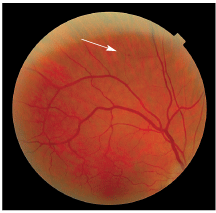
Can continue to exudate, bleed or thrombose.Ģ. OCT – Ring sign, span more than 1 retinal layer.Ĭourse- disappear in 3-6 months. Shapes – saccular, fusiform, pedunculated, focal bulge, irregular, mixed. < 30 microns can be seen on FFA and hence more microaneurysms are seen on FFA than fundus examination. Only > 30 microns is visible ophthalmoscopically (better on red-free illumination). But if you have a persistent bloody eye or frequent popped blood vessels on your eye, see an eye doctor.Appear as small round red dots - usually seen at the posterior pole, especially temporal to the fovea.

Remember: Subconjunctival hemorrhages are harmless and usually go away within a week or two. Keep any blood disorders or health problems (e.g., diabetes hypertension) under control with routine health care visits. See your physician or eye doctor to help prevent eye allergies and allergy-related coughing and sneezing. Get plenty of exercise and rest and eat a healthful diet to avoid getting sick.Ĭontrol your allergies. Clean and disinfect your contacts as directed, and don't overwear your lenses. If your eyes itch, see an eye doctor to determine the cause and possible treatments. Wear safety glasses and protective sports eyewear to avoid eye injuries.Īvoid rubbing your eyes.
#Dot blot hemorrhage eye how to#
How to prevent subconjunctival hemorrhagesįollow these tips to avoid a bloody eye from a popped blood vessel under the conjunctiva: If you are taking aspirin, blood thinners, or other medications, continue taking them unless your doctor instructs you to do otherwise. In some cases, eye drops (artificial tears) are recommended to keep the surface of the eye well-lubricated while the natural healing process takes place. There really is no treatment for subconjunctival hemorrhages. How are subconjunctival hemorrhages treated? Wearing contact lenses (increases eye rubbing)īut often, the cause of a subconjunctival hemorrhage is unknown. Having a "cold" or allergies (that increase coughing and sneezing) Risk factors for subconjunctival hemorrages include: Something as simple as a cough or a sneeze can cause a subconjunctival hemorrhage and bloody eye.Ī sudden increase in blood pressure (e.g., from lifting something heavy)Įye surgery, including LASIK and cataract surgery What causes a subconjunctival hemorrhage? If a subconjunctival doesn't go away completely or get significantly smaller within two weeks, see an eye doctor. During this time, the spot will become less red and more yellow in color as the blood is resorbed (removed) by the body. In most cases, a subconjunctival hemorrage will disappear on its own within a week or two. Sometimes, the bloody spot from a subconjunctival hemorrhage can expand to cover the entire white of your eye. Also, it might start as a small spot and get larger as the day goes on. It can be a relatively small spot or cover a large area of your sclera. The only symptom a bloody eye from a popped blood vessel might cause is a mild scratchy feeling on the surface of your eye.īut the primary sign of a subconjunctival hemorrhage - a bright red spot on the white of your eye - is unmistakeable. In some cases, it will cover the entire white area.Ī subconjunctival hemorrhage doesn't cause symptoms like blurry vision or eye pain. A red eye is an example of a sign.)Ī subconjunctival hemorrhage looks like a bright red spot on the white part of the eye. Signs are indicators that can be seen by others as well as the person experiencing them. Blurry vision is an example of a symptom. Symptoms are indicators of a condition that can be recognized only by the persing experiencing them. (The medical terms symptom and sign are often confused or misused. Subconjunctival hemorrhages usually don't have any symptoms.


Unlike a subconjunctival hemorrhage, a hyphema requires immediate attention from an eye doctor. Blood in the eye (behind the clear cornea) is a serious condition called a hyphema. Don't confuse it with blood in the front of the eye. Though it may look scary, a subconjunctival hemorrhage is harmless and typically goes away without treatment within a week or two.Ī subconjunctival hemorrhage is blood on the front of the eye. A subconjunctival hemorrhage can cause a small red spot on your eye or it can cover the entire sclera, causing a dramatic red, bloody eye. It's caused by a popped blood vessel under the thin, clear tissue ( conjunctiva) that covers the sclera. Schedule an exam Find Eye Doctor What is a subconjunctival hemorrhage?Ī subconjunctival hemorrhage is a bright red spot on the white of your eye ( sclera).


 0 kommentar(er)
0 kommentar(er)
